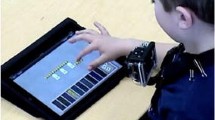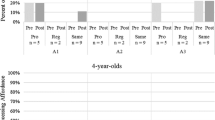Abstract
The purpose of this study was to explore relationships between app affordances and user abilities in second graders’ interactions with mathematics virtual manipulative touchscreen tablet apps. The research questions focused on varying manifestations of affordance–ability relationships during children’s interactions with mathematics virtual manipulative touchscreen tablet apps. Researchers qualitatively analyzed video recordings and ethograms from clinical interviews of 33 second-grade children. Each 45-min clinical interview involved one child interacting with two sequences of mathematics virtual manipulative touchscreen tablet apps: one sequence focusing on place value concepts and the other sequence focusing on skip counting concepts. Results provided evidence of Moyer-Packenham and Westenskow’s (Int J Virtual Pers Learn Environ 4(3):35–50, 2013) five affordance categories of virtual manipulatives. Approach to and degree of affordance access varied depending on a child’s corresponding ability, and some children modified their affordance access as their ability changed. Results also indicated that outcomes of accessing an affordance also related to a child’s ability. Context also influenced affordance access. These results imply that affordance–ability relationships are multifaceted. Overall, these results imply that is important to consider affordance–ability relationships in relation to mathematics education technology.



Similar content being viewed by others
Explore related subjects
Discover the latest articles, news and stories from top researchers in related subjects.References
Alibali, M. W., & Nathan, M. J. (2012). Embodiment in mathematics teaching and learning: Evidence from learners’ and teachers’ gestures. Journal of the Learning Sciences, 21(2), 247–286. doi:10.1080/10508406.2011.611446.
Baccaglini-Frank, A., & Maracci, M. (2015). Multi-touch technology and preschoolers’ development of number-sense. Digital Experiences in Mathematics Education, 1(1), 7–27. doi:10.1007/s40751-015-0002-4.
Barendregt, W., Lindström, B., Rietz-Leppänen, E., Holgersson, I., & Ottosson, T. (2012). Development and evaluation of Fingu: A mathematics iPad game using multi-touch interaction. In H. Schelhowe (Ed.), Proceedings of the 11th international conference on interaction design and children (pp. 204–207). New York, NY: ACM. doi:10.1145/2307096.2307126.
Bartoschek, T., Schwering, A., Li, R., & Münzer, S. (2013). Ori-Gami: An App fostering spatial competency development and spatial learning of children. In D. Vandenbroucke, B. Bucher, & J. Crompvoets (Eds.), Proceedings of the 15th AGILE international conference on geographic information science. Leuven: Springer.
Burlamaqui, L., & Dong, A. (2014). The use and misuse of the concept of affordance. In J. S. Gero (Ed.), Design computing and cognition DCC’14 (pp. 1–20). London: Springer.
Burlamaqui, L., & Dong, A. (2015). The identification of perceived intended affordances. In V. Popovic, A. L. Blackler, D.-B. Luh, N. Nimkulrat, B. Kraal, & Y. Nagai (Eds.), IASDR2015 Interplay (pp. 266–280). Australia: Brisbane.
Chemero, A. (2003). An outline of a theory of affordances. Ecological Psychology, 15(2), 181–195. doi:10.1207/S15326969ECO1502_5.
Gaver, W. W. (1991). Technology affordances. In Proceedings of the SIGCHI Conference on Human Factors in Computing Systems (pp. 79–84). New York, NY, USA: ACM. doi:10.1145/108844.108856
Gibson, J. J. (1986). The ecological approach to visual perception. Hillsdale, NJ: Lawrence Erlbaum.
Ginsburg, H. P., & Pappas, S. (2004). SES, ethnic, and gender differences in young children’s informal addition and subtraction: A clinical interview investigation. Journal of Applied Developmental Psychology, 25(2), 171–192. doi:10.1016/j.appdev.2004.02.003.
Greene, J. C. (2007). Mixed methods in social inquiry. New York: Wiley.
Greeno, J. G. (1994). Gibson’s affordances. Psychological Review, 101(2), 336–342. doi:10.1037/0033-295X.101.2.336.
Ladel, S., & Kortenkamp, U. (2012). Early maths with multi-touch—an activity-theoretic approach. In Proceedings of POEM 2012. http://cermat.org/poem2012/main/proceedings_files/Ladel-Kortenkamp-POEM2012.pdf
MacNulty, D. R., Mech, L. D., & Smith, D. W. (2007). A proposed ethogram of large-carnivore predatory behavior, exemplified by the wolf. Journal of Mammalogy, 88(3), 595–605. doi:10.1644/06-MAMM-A-119R1.1.
McLeod, J., Vasinda, S., & Dondlinger, M. J. (2012). Conceptual visibility and virtual dynamics in technology-scaffolded learning environments for conceptual knowledge of mathematics. Journal of Computers in Mathematics and Science Teaching, 31(3), 283–310.
Miles, M. B., Huberman, A. M., & Saldaña, J. (2013). Qualitative data analysis: A methods sourcebook (3rd ed.). Thousand Oaks, CA: Sage.
Moyer, P. S., Bolyard, J. J., & Spikell, M. A. (2002). What are virtual manipulatives? Teaching Children Mathematics, 8(6), 372–377.
Moyer-Packenham, P. S., Anderson, K. L., Shumway, J. F., Tucker, S. I., Westenskow, A., Boyer-Thurgood, J. M., et al. (2014). Developing research tools for young children’s interactions with mathematics apps on the iPad. In Proceedings of the 12th annual hawaii international conference on education (HICE) (pp. 1685–1694). Honolulu, Hawaii.
Moyer-Packenham, P. S., Baker, J., Westenskow, A., Anderson, K. L., Shumway, J. F., & Jordan, K. E. (2014b). Predictors of achievement when virtual manipulatives are used for mathematics instruction. REDIMAT - Journal of Research in Mathematics Education, 3(2), 121–150. doi:10.4471/redimat.
Moyer-Packenham, P. S., Bullock, E. P., Shumway, J. F., Tucker, S. I., Watts, C., Westenskow, A., et al. (2016). The role of affordances in children’s learning performance and efficiency when using virtual manipulatives mathematics iPad apps. Mathematics Education Research Journal,. doi:10.1007/s13394-015-0161-z.
Moyer-Packenham, P. S., Shumway, J. F., Bullock, E., Tucker, S. I., Anderson-Pence, K. L., Westenskow, A., et al. (2015). Young children’s learning performance and efficiency when using virtual manipulative mathematics iPad apps. Journal of Computers in Mathematics and Science Teaching, 34(1), 41–69.
Moyer-Packenham, P. S., & Suh, J. M. (2012). Learning mathematics with technology: The influence of virtual manipulatives on different achievement groups. Journal of Computers in Mathematics & Science Teaching, 31(1), 39–59.
Moyer-Packenham, P. S., & Westenskow, A. (2013). Effects of virtual manipulatives on student achievement and mathematics learning. International Journal of Virtual and Personal Learning Environments, 4(3), 35–50.
Moyer-Packenham, P. S., & Westenskow, A. (2016). Revisiting the effects and affordances of virtual manipulatives for mathematics learning. In K. Terry & A. Cheney (Eds.), Utilizing virtual and personal learning environments for optimal learning (pp. 186–215). Hershey, PA: Information Science Reference. doi:10.4018/978-1-4666-8847-6.ch009.
Murray, T., & Arroyo, I. (2002). Toward measuring and maintaining the Zone of Proximal Development in adaptive instructional systems. In S. A. Cerri, G. Gouardères, & F. Paraguaçu (Eds.), Intelligent tutoring systems (pp. 749–758). Berlin: Springer. doi:10.1007/3-540-47987-2_75.
National Council of Teachers of Mathematics. (2000). Principles and standards for school mathematics. Reston, VA: National Council of Teachers of Mathematics. http://www.nctm.org/standards/content.aspx?id=26792
Nemirovsky, R., Kelton, M. L., & Rhodehamel, B. (2013). Playing mathematical instruments: Emerging perceptuomotor integration with an interactive mathematics exhibit. Journal for Research in Mathematics Education, 44(2), 372–415. doi:10.5951/jresematheduc.44.2.0372.
Norman, D. A. (1988). The psychology of everyday things. New York: Basic Books.
Norman, D. A. (1999). Affordance, conventions, and design. Interactions, 6(3), 38–43. doi:10.1145/301153.301168.
Paek, S. (2012). The impact of multimodal virtual manipulatives on young children’s mathematics learning (Doctoral dissertation). Retrieved from ProQuest Dissertations & Theses Full Text. (UMI No. 3554708)
Quintana, C., Reiser, B. J., Davis, E. A., Krajcik, J., Fretz, E., Duncan, R. G., et al. (2004). A scaffolding design framework for software to support science inquiry. The Journal of the Learning Sciences, 13(3), 337–386.
Saldaña, J. (2013). The coding manual for qualitative researchers (2nd ed.). Thousand Oaks, CA: Sage.
Sarama, J., & Clements, D. H. (2009). Early childhood mathematics education research: Learning trajectories for young children. New York: Routledge.
Tucker, S. I. (2015). An exploratory study of attributes, affordances, abilities, and distance in children’s use of mathematics virtual manipulative iPad apps (Doctoral dissertation). http://gradworks.umi.com/37/23/3723089.html
Tucker, S. I. (in press). The modification of attributes, affordances, abilities, and distance for learning framework and its applications to interactions with mathematics virtual manipulatives. In International perspectives on teaching and learning mathematics with virtual manipulatives. Berlin: Springer.
Tucker, S. I., & Moyer-Packenham, P. S. (2014). Virtual manipulatives’ affordances influence student learning. In S. Oesterle, C. Nicol, P. Liljedahl, & D. Allan (Eds.), Proceedings of the Joint Meeting of PME 38 and PME-NA 36 (Vol. 6, p. 251). PME: Vancouver.
Tucker, S. I., Moyer-Packenham, P. S., Shumway, J. F., & Jordan, K. (in press). Zooming in on students’ thinking: How a number line app revealed, concealed, and developed students’ number understanding. Australian Primary Mathematics Classroom.
Wood, D., Bruner, J. S., & Ross, G. (1976). The role of tutoring in problem solving. Journal of Child Psychology and Psychiatry, 17(2), 89–100. doi:10.1111/j.1469-7610.1976.tb00381.x.
Zanchi, C., Presser, A. L., & Vahey, P. (2013). Next generation preschool math demo: Tablet games for preschool classrooms. In Proceedings of the 12th international conference on interaction design and children (pp. 527–530). New York, NY: ACM. doi:10.1145/2485760.2485857
Acknowledgments
Financial support for the work reported in this paper was provided for a project titled: Captivated! Young Children’s Learning Interactions with iPad Mathematics Apps, funded by the Vice President for Research Office category of Research Catalyst Funding at Utah State University, 2605 Old Main Hill, Logan, UT 84322, USA.
Author information
Authors and Affiliations
Corresponding author
Ethics declarations
Conflict of interest
The authors declare that they have no conflict of interest.
Appendix
Appendix
See Table 3.
Rights and permissions
About this article
Cite this article
Tucker, S.I., Moyer-Packenham, P.S., Westenskow, A. et al. The Complexity of the Affordance–Ability Relationship When Second-Grade Children Interact with Mathematics Virtual Manipulative Apps. Tech Know Learn 21, 341–360 (2016). https://doi.org/10.1007/s10758-016-9276-x
Published:
Issue Date:
DOI: https://doi.org/10.1007/s10758-016-9276-x




